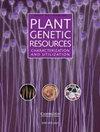Diversity in Indian wheat (T. aestivum L.) germplasm for various agro-morphological traits
IF 0.7
4区 生物学
Q3 PLANT SCIENCES
Plant Genetic Resources: Characterization and Utilization
Pub Date : 2023-07-21
DOI:10.1017/s1479262123000461
引用次数: 0
Abstract
A better understanding of diversity in landraces is essential for planning crosses for the development of trait specific varieties with better adaptability and stability. In the present study, 120 wheat genotypes comprised of landraces, genetic stocks, released varieties and improved genotypes were evaluated in randomized block design for 14 agro-morphological traits. The clustering method and principal component analysis (PCA) programme of Statistical Package for Agricultural Research (SPAR1) was used for grouping the genotypes. These 120 genotypes were grouped into nine clusters based on agro-morphological traits. These nine clusters differed significantly on the basis of mean values for 14 agro-morphological traits. PCA showed that the two principal components (PC1 to PC2) exhibited about 49% of the total variability. Scatter plot was constructed by plotting scores of PC1 and PC2. Based on mean values obtained over two years, the diverse superior genotypes were identified for utilization in hybridization programme. From the present study, we conclude that cluster analysis grouped the landraces with greater agro-morphological similarity into one group rather than geographical isolation indicating that geographical origin may not be the only factor causing diversity. Further, released varieties exhibited superiority for grain yield, while many landraces had higher values for number of tillers in a meter, biomass and thousand-grain weight (TGW). Thus, for the improvement in TGW in released varieties, the hybridization between superior landraces for TGW from cluster ‘E’ and released wheat varieties from cluster ‘C’ could give desirable segregates.印度小麦(T. aestivum L.)各种农业形态性状的种质多样性
更好地了解地方品种的多样性对培育适应性和稳定性更好的性状特异性品种的杂交规划至关重要。本研究采用随机区组设计,对由地方品种、遗传资源、释放品种和改良基因型组成的120个小麦基因型进行了14个农业形态性状的评价。采用聚类方法和农业研究统计软件包(SPAR1)主成分分析(PCA)程序对基因型进行分组。根据农业形态性状将这120个基因型分为9个聚类。在14个农业形态性状平均值的基础上,这9个聚类差异显著。主成分分析表明,两个主成分(PC1 ~ PC2)占总变率的49%左右。通过绘制PC1和PC2的分数构成散点图。根据两年来获得的平均值,鉴定出多种优良基因型,用于杂交计划。本研究表明,聚类分析将农业形态相似性较大的地方品种归为一类,而不是地理上的隔离,这表明地理来源可能不是造成多样性的唯一因素。此外,品种在籽粒产量方面表现出优势,而许多地方品种在分蘖数、生物量和千粒重(TGW)方面表现出较高的优势。因此,为了提高释放品种的TGW,将来自“E”集群的TGW优势地方品种与来自“C”集群的释放品种杂交可以获得理想的分离。
本文章由计算机程序翻译,如有差异,请以英文原文为准。
求助全文
约1分钟内获得全文
求助全文
来源期刊

Plant Genetic Resources: Characterization and Utilization
Agricultural and Biological Sciences-Agronomy and Crop Science
CiteScore
2.80
自引率
0.00%
发文量
29
审稿时长
>12 weeks
期刊介绍:
Plant Genetic Resources is an international journal which provides a forum for describing the application of novel genomic technologies, as well as their integration with established techniques, towards the understanding of the genetic variation captured in both in situ and ex situ collections of crop and non-crop plants; and for the airing of wider issues relevant to plant germplasm conservation and utilisation. We particularly welcome multi-disciplinary approaches that incorporate both a technical and a socio-economic focus. Technical aspects can cover developments in technologies of potential or demonstrated relevance to the analysis of variation and diversity at the phenotypic and genotypic levels.
 求助内容:
求助内容: 应助结果提醒方式:
应助结果提醒方式:


